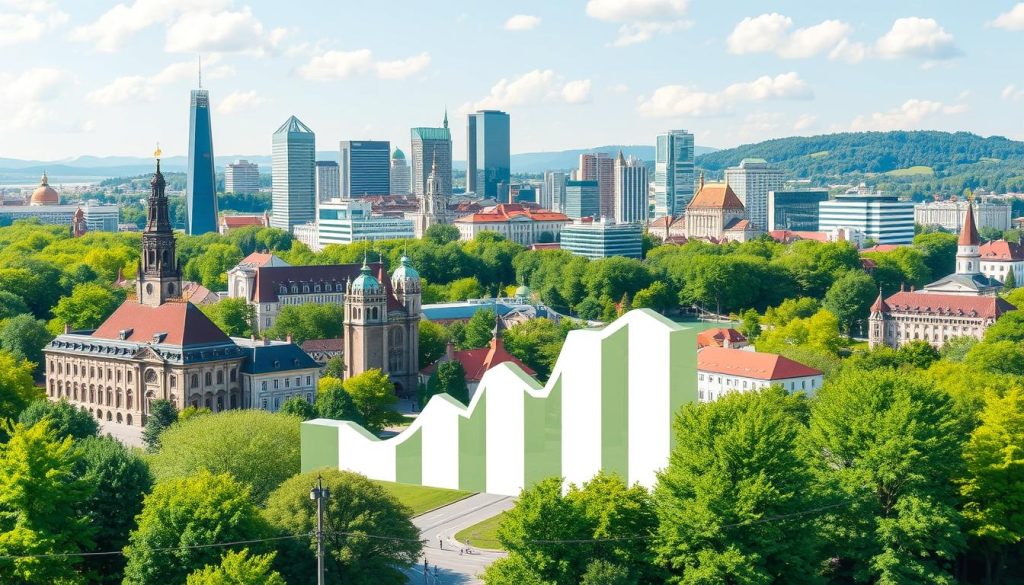In this article, we aim to give you a detailed look at the structural business statistics in Slovakia. We’ll explore the lively world of business in the country. Slovakia saw a 10.70% rise in new businesses in 2021. Yet, some rural and less developed areas showed slower growth.
It’s key to understand business demography to see the bigger picture of entrepreneurship. This helps us spot trends in new and old businesses, and those that grow fast. These trends shape the economy. We’ll look at important signs that show how businesses are doing in Slovakia.
By using databases like STATdata, we can learn more about the economy and society. This helps us understand how businesses change and how wages move in different fields. Join us as we dive into these important stats and what they mean for Slovakia’s economy.
Overview of Structural Business Statistics
Understanding structural business statistics is key to knowing the economic health and trends. In Slovakia, business demography statistics give us vital insights into the life cycle of businesses. They help us see how many new businesses start and how many close down.
This information shows the health of the business world. By looking at these numbers, we can understand how businesses begin and the hurdles they face.
Importance of Business Demography
Business demography is crucial for making economic policies and business plans. It shows the economy’s flow of new and closed businesses. This data helps in deciding where to put resources and how to grow the economy.
Knowing the birth rate of businesses helps spot growth chances. The death rate shows where we might need to step in to help.
Key Indicators in Slovakia
In 2021, Slovakia showed important signs in its business world. The birth rate of businesses was 10.70%, showing a strong start for new ventures. On the other hand, the death rate was 8.48%.
These numbers show Slovakia’s business scene is similar to the EU’s. They highlight the role of entrepreneurship in keeping the economy strong. Using the NACE system helps us see how businesses spread across different sectors. This helps us understand regional economic trends and guides policy decisions.
Enterprise Births and Deaths in Slovakia
Looking into enterprise births and deaths in Slovakia gives us a clear view of the business world. The year 2021 was interesting, showing trends seen across the EU. We’ll dive into the birth and death rates and how the economy affects them.
2021 Enterprise Birth Rate
In 2021, Slovakia’s business sector saw a steady growth. The birth rate was 10.70%, showing a strong flow of new businesses. This number is in line with the EU, where countries like France and Portugal had even higher rates.
This data shows Slovakia’s entrepreneurial spirit is strong. It shows the country is still a magnet for new businesses, even with economic ups and downs.
2021 Enterprise Death Rate
On the other hand, Slovakia’s death rate in 2021 was 8.48%. This shows businesses are tough and can handle tough times, like after COVID-19. It’s interesting that areas with lots of new businesses also see more closures.
This shows the idea of creative destruction at work. It drives innovation and growth in Slovakia’s economy.

High-Growth Enterprises in Slovakia
High-growth enterprises are key to Slovakia’s thriving economy. They are defined as businesses that grow by at least 10% each year from 2018 to 2021. These companies must also have at least 10 employees at the start of this period. This shows how important they are for creating jobs and driving innovation.
Definition and Significance
In 2021, the European Union saw about 151,300 high-growth enterprises. These businesses are vital for the economy. They bring new life to local areas and encourage new ideas.
By being innovation centers, they boost productivity. They also make the regions they operate in more competitive.
Impact on Economic Performance
High-growth enterprises are a big help in creating jobs in Slovakia. They make more jobs than regular businesses. This is a key part of their economic effect.
These firms change the economic scene in big ways. They push for more business innovation and improve the economy. As they grow, they help Slovakia stand out in the European market.
Wage Growth Trends in Slovakia
In recent times, Slovakia has seen a rise in wages. Both nominal and real wages have gone up. This change is seen across different sectors and regions.
Nominal and Real Wage Increases
By the first quarter of 2024, Slovakia’s nominal wages rose by 9% from the year before. The average monthly wage now stands at €1,447. This means workers have an extra €120 in their pockets.
Real wages, which adjust for inflation, have grown by 5.6%. This is the fastest growth in fifteen years. It shows that Slovak workers can buy more than before.
Sector-wise Analysis of Wage Changes
Different industries in Slovakia have seen varying wage changes. The electrical, gas, and steam supply sector has seen wages jump by over 20%. Trade and manufacturing have also seen significant increases of 8.1% and 11.5%, respectively.
These changes show that wages can vary a lot between sectors. This highlights the need to keep monitoring these changes for both workers and employers.
Regional Wage Variations
Wage differences between regions are key to understanding wage growth in Slovakia. For example, Bratislavský kraj has the highest average wage, over €1,000. On the other hand, Prešovský kraj and Trenčiansky kraj have lower averages, at €1,119 and €1,334, respectively.
While real wages have increased by over 5% in most regions, Nitriansky kraj saw a slower growth of 1.3%. These differences show how local economies affect wages across Slovakia.

Structural Business Statistics in Slovakia
We look at the structural statistics that help us understand Slovakia’s economy. We focus on the different sectors and their contributions. The NACE classification gives us insights into employment and industry trends.
In 2022, Slovakia’s GDP was USD 115.55 billion. It’s expected to grow to USD 157.08 billion by 2026. The GDP growth rate was 1.7% in 2022 but dropped to 1.1% in 2023. It’s expected to bounce back to 2.8% by 2026.
The general government gross debt was 57.8% of GDP in 2022. It’s forecasted to rise to 63.5% by 2026. These figures highlight the financial challenges we face.
Inflation jumped to 11% in 2023. But it’s expected to fall to around 2.5% by 2026. The unemployment rate has also improved, falling to 6.1% in 2023. It’s expected to stay near 5.9% soon.
The agriculture sector is vital, making up 2.2% of GDP and employing 3% of the workforce. The secondary sector, making 28.5% of GDP, has seen a 0.6% decline in industrial production in 2023. This indicates potential growth challenges.
The service sector is the largest, making up 58.5% of GDP and employing 62% of the workforce. However, retail trade turnover decreased in 2023. This shows changes in consumer behaviour and market dynamics.
The business environment score is 6.88/10, ranking Slovakia 37th out of 82 countries. This score reflects our economic health and the competitive landscape for businesses.
The Freight Road Transport industry is expected to be worth €5.2 billion in 2024. It has 12,645 businesses employing lorry drivers under EU Regulation 561/2006. This regulation aims to improve working conditions and road safety.
Conclusion
In our look at structural business statistics in Slovakia, we see a complex economic scene. The slowdown in GDP growth to 1.1% in 2023 shows we need strong plans to grow our economy. This is especially true as we look forward to a possible recovery, driven by private spending and car industry investments.
These statistics mean more than just numbers. They help us understand big changes in our economy. High inflation is a big challenge, making it hard to compete and affecting wages. But, with wages set to rise by 8.0%, there’s hope for better income levels.
Yet, we must watch out for inflation’s impact on spending and investments. Looking ahead, we face both hurdles and chances. The European Central Bank’s plan to lower interest rates and the push for nearshoring investments are key moments for Slovakia.
As we adjust to these changes, creating a business-friendly environment is crucial. It will help us reach our economic potential and boost our role in global trade.

